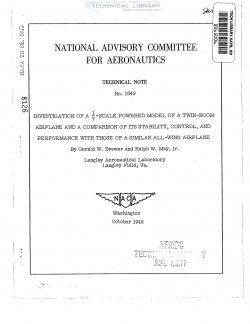naca-tn-1649
- Version
- 338 Downloads
- 2.83 MB File Size
- 1 File Count
- December 4, 2016 Create Date
- December 4, 2016 Last Updated
National Advisory Committee for Aeronautics, Technical Notes - Investigation of a 1/7 Scale Powered Model of a Twin Boom Airplane and a Comparison of Its Stability, Control, and Performance with those of a Similar Wing Airplane

An investigation of 51%- scale powered model of .a twin-boom airplane
was conducted in order to obtain a comparison of its stability, control,
and performance characteristics with those of an all-wing-airplane design
of the same over-all proportions. These models represent very large
airplanes having a gross weight of nearly 90 tons, a wing span of 290 feet,
and an aspect ratio of 10.6. The test results of the all-wing design
have been previously reported- The test results of the twin-boom model
are presented in this paper together with a summary comparison of the
characteristics of the two types of airplane.
At the design center-of-gravity location of 0-23 mean aerodynamic
chord the twin-boom airplane had about a 3—percent static margin in the
high-speed range with rated power and about a 5-percent static margin
at ‘low speed with propellers windmilling and. flap deflected #00. In
comparison, the all—wing airplane had a somewhat larger static margin
for rated-power operation but much less static longitudinal stability
at low speeds with propellers windmilling.
The twin-boom airplane possessed generally stable or neutrally
stable variations of trim elevator deflection with airspeed for all
conditions except for rated power with the flap deflected. The twin-
boom airplane had less stable trim elevator-deflection variations with
airspeed than the all-wing airplane because of the combination of the
lower degree of static longitudinal stability and increased elevator
effectiveness. In general, the twin-boom airplane had neutrally stable
trim elevator hinge-moment variations with airspeed as compared with
the more stable variations for the all-wing airplane- The elevator
effectiveness of the twin-boom airplane was nearly twice that for the
all-wing airplane.
Each airplane had a low degree of static directional stability and
also had a very low effective dihedral angle. The side force developed
by the twin-boom airplane in yaw was very low and was approximately
one-half that of the all-wing airplane.
| File | Action |
|---|---|
| naca-tn-1649 Investigation of a 1/7 Scale Powered Model of a Twin Boom Airplane and a Comparison of Its Stability, Control, and.pdf | Download |

Comment On This Post